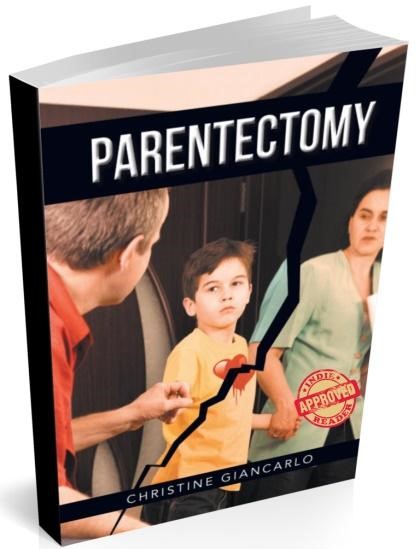July 24, 2019
Christine Giancarlo, Ph.D.
Senior Lecturer, Anthropology
Mount Royal University, Calgary
 I’m an anthropologist who studies human, and non-human, primates. I’m also a mother, author (Parentectomy, 2018), and feminist whose primary concern is for a healthy, sustainable future for all. Children are our collective hope for that future. As parents and adults, our job is to make sure that children have the best possible support during their development. Yet when parents divorce, kids are often relegated to the sidelines as the adults bicker, litigate, even fight for who gets the biggest award… measured in court-directed custody time. Research across cultures confirms that children are most likely to succeed in life when they have two parents who love and co-parent them. Whether a couple remains intact or divorced, they remain married to their children for life. This three-part blog uncovers the origin and necessity of two-parent families throughout human evolution as best-practice in child rearing.
I’m an anthropologist who studies human, and non-human, primates. I’m also a mother, author (Parentectomy, 2018), and feminist whose primary concern is for a healthy, sustainable future for all. Children are our collective hope for that future. As parents and adults, our job is to make sure that children have the best possible support during their development. Yet when parents divorce, kids are often relegated to the sidelines as the adults bicker, litigate, even fight for who gets the biggest award… measured in court-directed custody time. Research across cultures confirms that children are most likely to succeed in life when they have two parents who love and co-parent them. Whether a couple remains intact or divorced, they remain married to their children for life. This three-part blog uncovers the origin and necessity of two-parent families throughout human evolution as best-practice in child rearing.
Part 1 traces our human story from its earliest stages when our ancestors became bipedal to present-day. Part 2 considers parenting strategies of our closest mammal relatives, especially other primates, for evidence of shared-parenting outcomes. Part 3 is a mash-up of evolutionary, cross-species, and social science research that firmly places co-parenting as in the best interests of children.
PART 1
Fossil skeletons and footprints preserved in African volcanic ash up to five million years old show us that our ancestors walked much as we do today. These hominins were likely preoccupied with two main concerns: Finding food and… avoiding BEING food! Contrary to popular belief about “man” the hunter and our great brawn/ brain power, these hominins had a small brain (less than 1/3 the size of a modern human brain), lacked speed, claws, and sharp canine teeth. They were, essentially, sitting ducks for predators. Hominins gathered whatever plants they could find and occasionally scavenged meat left from other animals’ kills. So how did they survive and even flourish? Only through cooperation.
Cooperation provides safety in numbers, mate choice, greater success obtaining food, finding water, and brainstorming. It was cooperation, not competition, that allowed humans to survive then… and now.
The harnessing of fire about a million and a half years ago coincided with a much larger, more complex brain and the invention of sharp, two-sided stone tools. Now free-standing shelters could be made and protected by a hearth, food was cooked and meat became more accessible and less contaminated. The result was improved health, decreased mortality and an increased birth rate. Body size of these later hominins also increased, though there remained a significant difference in sexual dimorphism, males larger than females. As in all species, different size indicates different jobs: Males had a defense role in the group while females were smaller, requiring fewer calories to survive and reproduce. Both sexes and all group members had to cooperate to sustain their children, and their society.
Just eleven thousand or so years ago, somebody had the bright idea to plant seeds and grow crops. Groups cooperated to tend, harvest, and reap the benefits of a preferred and accessible diet. Agriculture was born and the village arose. The gathering and hunting lifestyle gave way to a new means of subsistence that required farm labour and defense of occupied land. Men defended and women ran the farms, cooperating to ensure a bountiful harvest and a healthy future generation.
The industrial revolution in the eighteenth century brought maximized production via machinery and human population growth skyrocketed. The village became the city, then the state. Land and resources became increasingly scarce and cooperation declined while competition increased. War became a means to defend or gain land; men became the warriors and women became the producers of the next generation of warriors. Males were thus rendered disposable by the state and an unspoken deal was struck: Men would be used as pawns to fight and die for the state… but they would also be given control (by law and religion) of “their” women to ensure and maximize paternity.
Over five million years, a species evolved from hominin to humankind, cooperative by nature but competitive by circumstance. Children were raised by cooperative parents within a group which ensured group survival in perpetuity. Patriarchy has only emerged recently in evolutionary time as a consequence of competition for resources. Though males and females differed to varying degrees in physical size and job, all parents played a crucial role in the well-being of their children.

Christine Giancarlo is author of the book, Parentectomy, which tells the stories of 30 capable, loving parents who became alienated from their children’s lives. Parentectomy is based on Christine’s peer-reviewed study, Kids Come Last: The Effect of Family Law Involvement in Parental Alienation (Giancarlo & Rottmann, 2015). Dr. Giancarlo’s research sheds light on an urgent and widespread social crisis, currently enabled by our broken family law system. Christine brings three decades of experience with parental alienation through interaction with young adults and her own personal journey. You can visit her website at christinegiancarlo.com.
